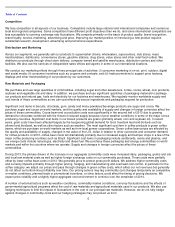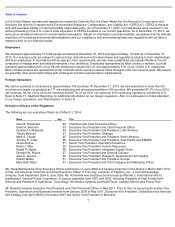Mondelez 2013 Annual Report Download - page 19
Download and view the complete annual report
Please find page 19 of the 2013 Mondelez annual report below. You can navigate through the pages in the report by either clicking on the pages listed below, or by using the keyword search tool below to find specific information within the annual report.
Table of Contents
to damage, disruptions or shutdowns due to failures during the process of upgrading or replacing software, databases or
components thereof, power outages, hardware failures, computer viruses, attacks by computer hackers or other cybersecurity risks,
telecommunication failures, user errors, natural disasters, terrorist attacks or other catastrophic events. Furthermore, any of the
aforementioned impacts to our business could be prolonged to the extent such information technology systems are managed by
third parties or used in connection with external shared service centers, as we will have to coordinate with such third parties for the
resolution of any risks presented. If any of our significant information technology systems suffer severe damage, disruption or
shutdown, and our disaster recovery and business continuity plans do not effectively resolve the issues in a timely manner, our
product sales, financial condition and results of operations may be materially and adversely affected, and we could experience
delays in reporting our financial results.
In addition, if we are unable to prevent physical and electronic break-ins, cyber-attacks and other information security breaches, we
may suffer financial and reputational damage, litigation or remediation costs or penalties because of the unauthorized disclosure of
confidential information belonging to us or to our partners, customers, suppliers or employees. The disclosure of non-public
sensitive or protected information through external media channels could lead to the loss of intellectual property or damage our
reputation and brand image. Misuse, leakage or falsification of legally protected information could also result in a violation of data
privacy laws and regulations, damage our reputation and credibility, and have a negative impact on our business, financial
condition and results of operations.
Weak financial performance, downgrades in our credit ratings, illiquid global capital markets and volatile global economic
conditions could limit our access to the global capital markets, reduce our liquidity and increase our borrowing costs.
From time to time we may need to access the long-term and short-term global capital markets to obtain financing. Our financial
performance, our short- and long-term credit ratings, the liquidity of the overall global capital markets and the state of the global
economy, including the food industry, will affect our access to, and the availability or cost of, financing on acceptable terms and
conditions in the future. There can be no assurance that we will have access to the global capital markets on terms we find
acceptable.
We regularly access the U.S. and euro commercial paper markets for ongoing funding requirements. A downgrade in our credit
ratings would increase our borrowing costs and could adversely affect our ability to issue commercial paper. Disruptions in the
global commercial paper market or other effects of volatile economic conditions on the global credit markets also could reduce the
amount of commercial paper that we could issue and could raise our borrowing costs for both short- and long-term debt offerings.
Our inability to access the global capital markets or an increase in our borrowing costs could materially and adversely affect our
financial condition and results of operations.
Volatility in the equity markets, interest rates or other factors could substantially increase our pension costs.
We sponsor a number of defined benefit pension plans for our employees throughout the world. At the end of 2013, the projected
benefit obligation of our defined benefit pension plans was $11.2 billion and plan assets were $9.2 billion. The difference between
plan obligations and assets, or the funded status of the plans, significantly affects the net periodic benefit costs of our pension plans
and the ongoing funding requirements of those plans. Our major defined benefit pension plans are funded with trust assets invested
in a globally diversified portfolio of investments, including equities and corporate debt. Among other factors, changes in interest
rates, mortality rates, early retirement rates, investment returns, minimum funding requirements in the jurisdictions in which the
plans operate, arrangements made with the trustees of certain plans and the market value of plan assets can affect the level of plan
funding, cause volatility in the net periodic pension cost and increase our future funding requirements. Legislative and other
governmental regulatory actions may also increase funding requirements for our pension plans’ benefits obligation.
Based on current tax laws, we estimate our 2014 pension contributions will be approximately $319 million. We also expect that our
net pension cost will decrease to approximately $263 million in 2014 from $357 million in 2013. The decrease is primarily due to
higher discount rates and favorable asset performance. However, volatility in the global capital markets may increase the risk that
we are required to make additional cash contributions to the pension plans and recognize further increases in our net pension cost
beyond 2014. Some of our pension trust assets are invested in European sovereign debt and subject to heightened risk that they
could lose value as a result of political and financial turmoil in Europe.
15
























